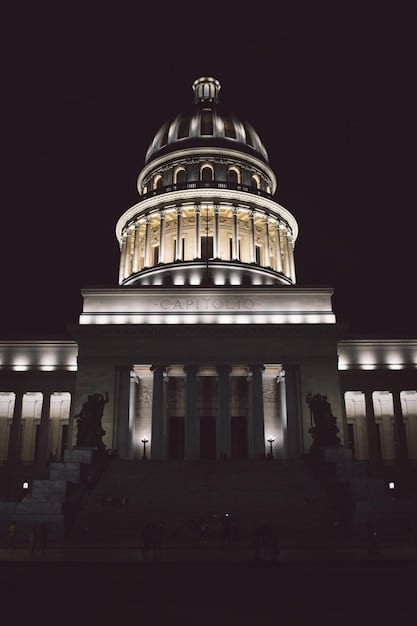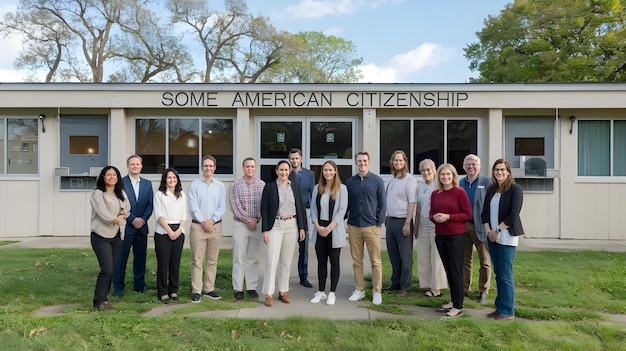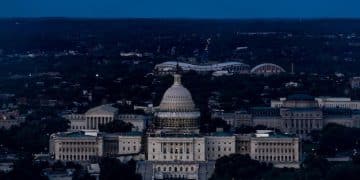Government Shutdown Looms: Impact on US Essential Services

A potential government shutdown in the US threatens to disrupt essential services, affecting everything from national parks to federal agencies, and potentially impacting millions of Americans.
As negotiations continue, the possibility of a government shutdown looms large in the United States. This situation raises serious concerns about how essential services across the US will be affected, impacting citizens nationwide.
Understanding the Impending Government Shutdown
A government shutdown occurs when Congress fails to pass appropriation bills or a continuing resolution to fund federal government operations. This leads to a temporary closure of non-essential federal agencies and services, impacting a wide range of activities and the people who rely on them.
What Triggers a Government Shutdown?
The US government’s fiscal year begins on October 1st. To avoid a shutdown, Congress must pass, and the President must sign, appropriation bills that fund the government. When this doesn’t happen, a shutdown ensues.
Historical Context of Government Shutdowns
Government shutdowns are not new. The US has experienced several in the past, with varying degrees of impact. Some notable shutdowns include those in 1995-96 and 2013, which led to significant disruptions.
- Shutdowns are triggered by failure to pass funding bills.
- They lead to the closure of non-essential federal agencies.
- Past shutdowns have caused widespread disruptions.
Understanding the reasons behind these shutdowns and their historical context offers insight into the current situation. The political climate and budgetary disagreements often play critical roles in the lead-up to a shutdown.
The Immediate Impact on Federal Employees
One of the most direct consequences of a government shutdown is its effect on federal employees. Many are furloughed, meaning they are temporarily out of work without pay. This can cause significant financial strain and uncertainty.

Furloughs and Unpaid Leave
During a shutdown, non-essential federal employees are placed on furlough. They are required to stay home and do not receive their salaries until the government reopens. Essential employees continue to work, often without guaranteed timely payment.
Financial Strain and Uncertainty
The financial strain on federal employees can be considerable. Many live paycheck to paycheck and struggle to meet their financial obligations during a shutdown. This can lead to increased stress and anxiety.
The shutdown’s immediate impact is felt most acutely by those who serve the government. The uncertainty surrounding their employment and financial stability is a significant concern.
Effects on National Parks and Recreation
National parks and recreational areas often face closures during a government shutdown. This not only affects tourists and visitors but also local communities that depend on park-related revenue.
Park Closures and Reduced Services
Many national parks close entirely, while others reduce services significantly. This means visitors may be unable to access popular attractions, hiking trails, and campgrounds. Essential services like visitor centers and restrooms may also be shuttered.
Economic Impact on Local Communities
Communities near national parks often rely on tourist spending. When parks close, hotels, restaurants, and other businesses suffer, leading to revenue loss and potential layoffs.
The closure of national parks has far-reaching consequences, impacting tourists, local businesses, and the overall economy. These recreational areas provide not only leisure opportunities but also contribute substantially to the economic well-being of nearby communities.
Healthcare and Social Services Disruption
A government shutdown can disrupt healthcare and social services, affecting vulnerable populations who rely on these programs. Delays in processing applications and providing benefits can have serious consequences.

Impact on Medicare and Medicaid
While essential healthcare services continue, a shutdown can delay processing of Medicare and Medicaid applications and claims. This can create financial hardships for beneficiaries and healthcare providers.
Delays in Social Security and Veterans’ Benefits
Social Security and veterans’ benefits are generally considered essential, but a shutdown can still cause delays in processing new applications and resolving issues. This can affect millions of Americans who depend on these payments.
- Shutdowns can delay Medicare and Medicaid processing.
- Social Security and veterans’ benefits may face delays.
- Vulnerable populations are disproportionately affected.
These disruptions in healthcare and social services underscore the critical role government plays in ensuring the well-being of its citizens. Even temporary delays can have significant and lasting effects.
Travel and Transportation Security Risks
Travel and transportation security can be compromised during a government shutdown. Reduced staffing at airports and border crossings can lead to longer wait times and potential security risks.
TSA and Air Traffic Control Staffing
The Transportation Security Administration (TSA) and air traffic controllers are considered essential employees, but they may be required to work without pay during a shutdown. This can lead to morale issues and potential staffing shortages.
Border Security and Customs Delays
Reduced staffing at border crossings can result in longer wait times for travelers and delays in processing goods. This can impact international trade and economic activity.
Compromised travel and transportation security poses risks to both domestic and international travelers. The potential for longer wait times and reduced security measures is a significant concern.
The Long-Term Economic Consequences
Beyond the immediate disruptions, a government shutdown can have long-term economic consequences. These include reduced economic growth, decreased consumer confidence, and damage to the country’s reputation.
Reduced Economic Growth
Government shutdowns can decrease economic activity as federal spending slows and consumer confidence declines. This can lead to lower GDP growth and job losses.
Damage to the Country’s Reputation
Frequent government shutdowns can damage the country’s reputation as a stable and reliable economic partner. This can deter foreign investment and harm international relations.
The long-term economic consequences of a government shutdown can be significant and far-reaching. These effects can undermine the country’s economic stability and international standing.
Potential Solutions and Ways to Mitigate Impact
To mitigate the impact of a government shutdown, lawmakers can pursue various solutions. These include passing timely appropriation bills, crafting bipartisan agreements, and implementing measures to protect essential services.
The Role of Bipartisan Agreements
Bipartisan agreements are essential to avoiding government shutdowns. When lawmakers from both parties work together to find common ground, they can pass legislation that funds the government and addresses critical issues.
Measures to Protect Essential Services
In the event of a shutdown, measures can be taken to protect essential services. These include prioritizing funding for critical programs and ensuring that essential employees continue to work.
Addressing the potential impact of a government shutdown requires proactive measures and a commitment to finding common ground. By working together, lawmakers can minimize disruptions and protect the interests of the American people.
| Key Point | Brief Description |
|---|---|
| 🚨 Shutdown Trigger | Failure to pass funding bills by Congress. |
| 💼 Federal Employees | Furloughs and potential delays in pay. |
| 🏞️ National Parks | Park closures and reduced services impact tourism. |
| ⚕️ Healthcare | Delays in Medicare and Medicaid processing. |
Frequently Asked Questions (FAQ)
▼
A government shutdown occurs when Congress fails to pass appropriation bills or continuing resolutions to fund federal government operations, leading to the closure of non-essential federal agencies.
▼
Many federal employees are furloughed, meaning they are temporarily out of work without pay. Essential employees continue to work, often without guaranteed timely payment, causing financial strain.
▼
National parks often face closures or reduced services, impacting tourists, local communities, and the economy. Many popular attractions and services may be inaccessible during this time.
▼
While essential healthcare services continue, shutdowns can delay processing of Medicare and Medicaid applications and claims, leading to financial hardships for beneficiaries and healthcare providers.
▼
Government shutdowns can lead to reduced economic growth, decreased consumer confidence, and damage to the country’s reputation, deterring foreign investment and harming international relations.
Conclusion
The potential for a government shutdown in the US presents significant challenges to essential services and the well-being of citizens. From impacting federal employees and healthcare to disrupting national parks and transportation, the consequences could be far-reaching. Addressing these concerns requires proactive measures, bipartisan cooperation, and a commitment to ensuring the stability and reliability of government services.





